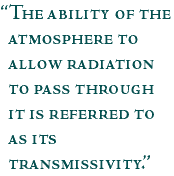

Absorption Bands and Atmospheric Windows |
Some types of electromagnetic radiation easily pass through the atmosphere, while other types do not. The ability of the atmosphere to allow radiation to pass through it is referred to as its transmissivity, and varies with the wavelength/type of the radiation. The gases that comprise our atmosphere absorb radiation in certain wavelengths while allowing radiation with differing wavelengths to pass through. The areas of the EM spectrum that are absorbed by atmospheric gases such as water vapor, carbon dioxide, and ozone are known as absorption bands. In the figure, absorption bands are represented by a low transmission value that is associated with a specific range of wavelengths. In contrast to the absorption bands, there are areas of the electromagnetic spectrum where the atmosphere is transparent (little or no absorption of radiation) to specific wavelengths. These wavelength bands are known as atmospheric "windows" since they allow the radiation to easily pass through the atmosphere to Earth's surface. Most remote sensing instruments on aircraft or space-based platforms operate in one or more of these windows by making their measurements with detectors tuned to specific frequencies (wavelengths) that pass through the atmosphere. When a remote sensing instrument has a line-of-sight with an object that is reflecting sunlight or emitting heat, the instrument collects and records the radiant energy.While most remote sensing systems are designed to collect reflected radiation, some sensors, especially those on meteorological satellites, directly measure absorption phenomena, such as those associated with carbon dioxide (CO2) and other gases. The atmosphere is nearly opaque to EM radiation in part of the mid-IR and all of the far-IR regions. In the microwave region, by contrast, most of this radiation moves through unimpeded, so radar waves reach the surface (although weather radars are able to detect clouds and precipitation because they are tuned to observe backscattered radiation from liquid and ice particles). |

Remote Sensing Related Data Sets: |
 Diagram of atmospheric windows—wavelengths at which electromagnetic radiation will penetrate the Earth's atmosphere. Chemical notation (CO2, O3) indicates the gas responsible for blocking sunlight at a particular wavelength. next: Spectral Signatures |